| The Roaring 1920s (1920 - 1929) | The Down Falling 1930s (1930 - 1939) | The Traumatic 1940s (1940 - 1949) |
The 1930s, pronounced "the Thirties", was the decade that started on January 1, 1930 and ended on December 31, 1939. It was the fourth decade of the 20th century. It is sometimes referred to as the Dirty Thirties. After the largest stock market crash in America's history, much of the decade was in an economic downfall, called The Great Depression that had a traumatic effect worldwide. In response authoritarian regimes emerged in several countries in Europe, in particular the Second Reich in Germany which was renamed the Third Reich. Weaker states including Ethiopia, China and Ukraine were subjugated by their stronger expansionist neighbours, and this ultimately led to the Second World War by the decade's end. The decade also saw a proliferation in new technologies, including intercontinental aviation and radio.
War Broke out in South America[]
Chaco War[]
Border skirmishes throughout the late 1920s culminated in an all-out war in 1932, after the Bolivian army, following orders of President Daniel Salamanca, attacked a Paraguayan garrison at Lake Pitiantuta in June. They later occupied another garrison further south, called Fortín Boquerón. This stronghold would later become the scene of one of the bloodiest and protracted battles of this war, when some 600 Bolivian soldiers resisted a 22-day siege, against 14,000 Paraguayan troops before surrendering (7-29 September 1932).
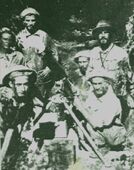
A machine gun manned by Paraguayan soldiers.
Paraguay received military supplies and intelligence from Argentina, and the Paraguayans took advantage of their ability to communicate over the radio in Guaraní, which was not intelligible to the typical Bolivian soldier. Paraguay had little trouble in mobilizing its troops in large barges on the Paraguay river right to the frontlines, whilst the majority of Bolivian soldiers came from the western highlands, some eight hundred km away and with little or no logistic support. In fact, it took a typical Bolivian soldier about 14 days to traverse the distance, while a Paraguayan soldier only took about four. The heavy equipment of Bolivia's army made things worse. The supply of water, given the dry climate of the region, also played a key role during the conflict. There were thousands of non-combat casualties due to dehydration, mostly among Bolivian troops.
The Chaco War is also important historically as the first instance of large scale aerial warfare to take place in the Americas (in the war between Chile and Peru two year before, only were used a few airplanes). Both sides made use of obsolete single-engined biplane bombers; despite an international arms embargo imposed by the League of Nations, Bolivia in particular went to great lengths in trying to import a small number of Curtiss T-32 Condor II twin-engined bombers masqueraded as civil transports, only to be halted in Peru during deliveries. At Ballivian, the last ever dogfight between bi-planes took place.
While the military conflict ended with a comprehensive Paraguayan victory, from a wider point of view it was a disaster for both sides. Bolivia's European elite forcibly enlisted the large indigenous population into the army, though they felt little connection to the nation-state, while Paraguay was able to foment nationalist fervour among its predominantly mixed population. On both sides, but more so in the case of Bolivia, soldiers were ill-prepared for the dearth of water or the harsh conditions of terrain and climate they encountered. The effects of the altitude had maimed the Bolivian army: most of the indigenous soldiers lived on the cold Altiplano at altitudes of over 12,000 feet (3,700 m). They found themselves at a physical disadvantage when called upon to fight in sub-tropical temperatures at almost sea level. In fact, of the war's 100,000 casualties (about 57,000 of the total were Bolivian), more died from diseases such as malaria and other infections than from the actual fighting. At the same time, the war brought both countries to the brink of economic disaster.
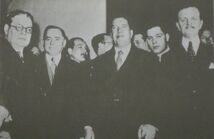
Signatories of the 1938 Peace Treaty gather in Buenos Aires.
On November 27, 1934, Bolivian generals, frustrated by the progress of the war, seized President Salamanca while he was visiting their headquarters in Villa Montes and replaced him with the vice-president, José Luis Tejada.
By the time a ceasefire was negotiated for noon June 10, 1935, Paraguay controlled most of the region. In the last half hour there was a senseless shoot-out between the armies. This was recognized in a 1938 truce, signed in Buenos Aires, Argentina, by which Paraguay was awarded three-quarters of the Chaco Boreal, 20,000 sq mi. Two Paraguayans and three Bolivians died for every sq mi. Bolivia did get the remaining territory, that bordered the Paraguay's River Puerto Busch. Some years later it was found that there were no oil resources in the Chaco Boreal kept by Paraguay, yet the territories kept by Bolivia were, in fact, rich in natural gas and petroleum, these being at the present time the country's largest exports and source of wealth.
Tacna War []
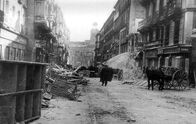
Lima after the Battle
By late 1929, began the so-called Great Battle of Lima, which made its debut the new Air Force of Chile, bombing the city's defenses.
The fighting took place mainly on the outskirts of Lima, and extended until January 3, 1930, when finally the last of the Peruvian Army garrison surrendered to the Chilean forces. Shortly before the fall of Lima, Peru's President Augusto Leguia moved to the city of Huacho, where he planned to subsequently move the seat of government to the north. However, while there, part of a regiment revolted with the intention of deposing him and arrest him. Leguía refused and the soldiers fired, killing him. A few hours later, with the arrival of other troops, the uprising was crushed.
After Leguía's death, a group of politicians and military men shaped rapidly a provisional Junta of government. After stating the serious losses suffered up to this moment, especially during the battle in Lima, the Junta decided to accept a peace with Chile for ends of January, 1930. Nevertheless, the decision was not respected by some Peruvian troops that continued the hostilities against the Chilean forces until middle of July.
Finally, the peace between both countries was signed the day of October 16, 1930, after which the Chilean troops left the occupied territories.
Peruvian Civil War[]
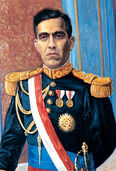
General Luis Sánchez Cerro
With the defeat in the War of Tacna, the country fell into a period of crisis, aggravated by the Great Depression of 1929. Peace with Chile was signed by a civilian-military junta formed in 1930 to replace President Leguia, killed during an uprising during the war. With important part of the industry destroyed, protests erupted throughout Peru, which led the government to commit brutal repression. After a call for elections, took a civilian government in 1934. However, the difficult situation was exploited by Colombia and Ecuador to achieve resolution of their territorial disputes. This potential threat of another war, led the Peruvian government to yield to the claims of their neighbors, signing treaties in 1934 and 1935. However, this provoked strong opposition from various domestic sectors, including the armed forces. In late 1936, an insurrection in Piura unleashed a Civil War in Peru. The conflict lasted until 1937, when the revolutionary forces entered Lima, installing a pro-fascist government at the head of General Luis Sánchez Cerro.
The Dust Bowl[]
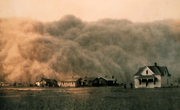
A dust storm approaches Stratford, Texas, in 1935.
The Dust Bowl or the Dirty Thirties was a period of severe dust storms causing major ecological and agricultural damage to American and Canadian prairie lands from 1930 to 1936 (in some areas until 1940). The phenomenon was caused by severe drought coupled with decades of extensive farming without crop rotation, fallow fields, cover crops or other techniques to prevent erosion. Deep plowing of the virgin topsoil of the Great Plains had displaced the natural grasses that normally kept the soil in place and trapped moisture even during periods of drought and high winds.

Buried machinery in a barn lot; Dallas, South Dakota, May 1936
During the drought of the 1930s, with no natural anchors to keep the soil in place, it dried, turned to dust, and blew away eastward and southward in large dark clouds. At times the clouds blackened the sky reaching all the way to East Coast cities such as New York and Washington, D.C. Much of the soil ended up deposited in theAtlantic Ocean, carried by prevailing winds which were in part created by the dry and bare soil conditions itself. These immense dust storms—given names such as "Black Blizzards" and "Black Rollers"—often reduced visibility to a few feet (around a meter). The Dust Bowl affected 100,000,000 acres (400,000 km2), centered on thepanhandles of Texas and Oklahoma, and adjacent parts of New Mexico, Colorado, and Kansas.
Millions of acres of farmland became useless, and hundreds of thousands of people were forced to leave their homes; many of these families (often known as "Okies", since so many came from Oklahoma) traveled to California and other states, where they found economic conditions little better than those they had left. Owning no land, many traveled from farm to farm picking fruit and other crops at starvation wages.
Second Sino-Japanese War[]

A group of National Revolutionary Army soldiers, from Sun Li-jen New First Army, marching off while a plane flies by overhead during the Burma campaign.
Few Chinese had any illusions about Japanese designs on China. Hungry for raw materials and pressed by a growing population, Japan initiated the seizure of Manchuria in September 1931 and established ex-Qing emperor Pu-yi as head of the puppet state of Manchukuo in 1932. The loss of Manchuria, and its vast potential for industrial development and war industries, was a blow to the Kuomintang economy. The League of Nations, established at the end of World War I, was unable to act in the face of the Japanese defiance. The Japanese began to push from south of the Great Wall into northern China and into the coastal provinces. Chinese fury against Japan was predictable, but anger was also directed against the Republic of China government, which at the time was more preoccupied with anti-Communist extermination campaigns than with resisting the Japanese invaders. The importance of "internal unity before external danger" was forcefully brought home in December 1936, when Chiang Kai-shek, in an event now known as the Xi'an Incident was kidnapped by Zhang Xueliang and forced to ally with the Communists against the Japanese as a condition of his release.
The Chinese resistance stiffened after July 7, 1937, when a clash occurred between Chinese and Japanese troops outside Beijing (then renamed Beiping) near the Marco Polo Bridge. This skirmish not only marked the beginning of open, though undeclared, war between China and Japan but also hastened the formal announcement of the Second Kuomintang-CCP United Frontagainst Japan. Shanghai fell after a three month battle which ended after severe Japanese naval and army casualties. The capital of Nanjing fell in December 1937. It was followed by a series of mass killings and rape of civilians in the Nanjing Massacre. In 1940 the collaborationist Wang Jingwei regime was set up with its capital in Nanjing, proclaiming itself the legitimate "Republic of China" in opposition to Chiang Kai-shek's government, though its claims were significantly hampered due to its nature as a Japanese puppet state controlling limited amounts of territory, along with its subsequent defeat at the end of the war.
Hitler Rise to Power[]

Harzburger Front of 1931, a coalition of nationalist conservatives and the extreme right
In order to secure a majority for his NSDAP in the Reichstag, Hitler called for new elections. On the evening of 27 February 1933, a fire was set in the Reichstag building. Hitler swiftly blamed an alleged Communist uprising, and convinced Chancellor Alfred Wilhelm Hugenberg to sign the Reichstag Fire Decree. This decree, which would remain in force until 1945, repealed important political and human rights of the Weimar constitution. Communist agitation was banned, but at this time not the Communist Party itself.
Eleven thousand Communists and Socialists were arrested and brought into concentration camps, where they were at the mercy of the Gestapo, the newly established secret police force (9,000 were found guilty and most executed). Communist Reichstag deputies were taken into protective custody (despite their constitutional privileges).
Despite the terror and unprecedented propaganda, the last free General Elections of 5 March 1933, while resulting in 43.9% failed to bring the majority for the NSDAP that Hitler had hoped for. Together with the German National People's Party (DNVP), however, he was able to form a slim majority government. With accommodations to the Catholic Centre Party, Hitler succeeded in convincing a required two-thirds of a rigged Parliament to pass the Enabling act of 1933 which gave his government full legislative power. Only the Social Democrats voted against the Act. The Enabling Act formed the basis for the dictatorship,; the trade unions and all political parties other than the National Socialist (Nazi) Party were suppressed. A centralised totalitarian state was established, no longer based on the Monarchial constitution. Germany left the League of Nations. The coalition parliament was rigged on this fateful 23 March 1933 by defining the absence of arrested and murdered deputies as voluntary and therefore cause for their exclusion as wilful absentees. Subsequently in July the Centre Party was voluntarily dissolved in a quid pro quo with the Holy See under the anti-communist Pope Pius XI for the Reichskonkordat; and by these manoeuvres Hitler achieved movement of these Catholic voters into the Nazi party, and a long-awaited international diplomatic acceptance of his regime. It is interesting to note however that according to Professor Dick Geary the Nazis gained a larger share of their vote in Protestant than in Catholic areas of Germany in elections held between 1928 to November 1932 The Communist Party was proscribed in April 1933 . On the weekend of 30 June 1934, he gave order to the SS to seize Röhm and his lieutenants, and to execute them without trial (known as the Night of the Long Knives). Upon Hugenberg's death on 2 August 1934, with support from the King, Hitler's cabinet passed a law proclaiming the presidency vacant and transferred the role and powers of the head of state to Hitler as Führer und Reichskanzler (leader and chancellor).

Adolf Hitler
However, many leaders of the Nazi SA were disappointed. The Chief of Staff of the SA, Ernst Röhm, was pressing for the SA to be incorporated into the Wehrmacht under his supreme command. Hitler felt threatened by these plans.
The SS became an independent organisation under the command of the Reichsführer SS Heinrich Himmler. He would become the supervisor of the Gestapo and of the concentration camps, soon also of the ordinary police. Hitler also established the Waffen-SS as a separate troop.
Hitler re-established the German air force and reintroduced universal military service. The open rearmament was in flagrant breach of the Treaty of Versailles, but neither the United Kingdom, France or Italy went beyond issuing notes of protest.
His reputation was going to increase further with the 1936 Summer Olympics, which were held in the same year in Berlin and in Garmisch-Partenkirchen, and which proved another great propaganda success for the regime.
After establishing the "Rome-Berlin axis" with Mussolini, and signing the Anti-Comintern Pact with Japan - which was joined by Italy a year later in 1937 - Hitler felt able to take the offensive in foreign policy. On 12 March 1938, German troops marched into Austria, where an attempted Nazi coup had been unsuccessful in 1934.
Spanish Civil War[]
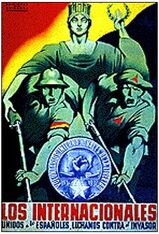
Republican poster featuring the International Brigades. The text reads We the Internationals, united with the Spanish people, fight the invader.
The Spanish Civil War was a major conflict that devastated Spain from 17 July 1936 to 1 April 1939. It began after an attempted coup d'état by a group of Spanish Army generals against the government of the Second Spanish Republic, then under the leadership of president Manuel Azaña. The nationalist coup was supported by the conservative Spanish Confederation of the Autonomous Right (Confederación Española de Derechas Autónomas, or C.E.D.A), monarchists known as Carlist groups, and the Fascist Falange (Falange Española de las J.O.N.S.). Following the partially successful coup, Spain was left divided as supporters of the existing Republican government fought the forces of the new Nationalist government for control of the country. The war ended with the victory of the Nationalists, the overthrow of the Republican government, and the founding of an authoritarian stateled by General Francisco Franco. In the aftermath of the civil war, all right-wingparties were fused into the state party of the Franco regime.
The Nationalists (nacionales) received the support of Fascist Italy and Nazi Germany, as well as neighbouring Portugal. The Communist Soviet Unionintervened on the Republican side, although it encouraged factional conflict to the benefit of the Soviet foreign policy, and its actions may have been detrimental to the Republican war effort as a whole. The United States government offered no official support for either side, although over two thousand Americans volunteered on the Republican side. Meanwhile, American corporations such as Texaco, General Motors, Ford Motors, and The Firestone Tire and Rubber Company greatly assisted the Nationalist army, furnishing a regular supply of trucks, tires, machine tools, and fuel.
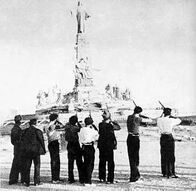
"Execution" of the Sacred Heart of Jesus by Communist militiamen at Cerro de los Ángeles near Madrid, on 7 August 1936, was the most infamous of the widespread desecration of religious property. The photograph in the London Daily Mail had the caption the "Spanish Reds' war on religion."
The new tank warfare tactics and the terror bombing of cities from the air were features of the Spanish Civil War which played a significant part in the later general European war.
The Spanish Civil War has been dubbed "the first media war", with several writers and journalists covering it wanting their work "to support the cause". Foreign correspondents and writers covering it included Ernest Hemingway, Georges Bernanos, Martha Gellhorn, Cesar Vallejo, George Orwell, Halfdan Rasmussen and Robert Capa. Like most international observers, they tended to support the Republicans, with some such as Orwell participating directly in the fighting.
Like most civil wars, it became notable for the passion and political division it inspired, and for atrocities committed on both sides of the conflict. The Spanish Civil War often pitted family members, neighbors, and friends against each other. Apart from the combatants, many civilians were killed for their political or religious views by both sides, and after the war ended in 1939, the losing Republicans were persecuted by the victorious Nationalists.
An estimated total of more than 300,000 people lost their lives as a consequence of the war. Out of them probably more than 120,000 were civilians executed by either side.
Roosevelt's "New Deal"[]
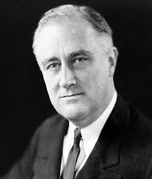
President Franklin Delano Roosevelt
In the United States, upon accepting Democratic nomination for president in 1932, Franklin D. Roosevelt promised "a new deal for the American people," a phrase that has endured as a label for his administration and its many domestic achievements. The Republicans, blamed for the Depression, or at least for lack of an adequate response to it, were easily defeated by Roosevelt in 1932
Unlike many other world leaders in the 1930s, however, Roosevelt entered office with no single ideology or plan for dealing with the depression. The "new deal" was often contradictory, pragmatic, and experimental. What some considered incoherence of the New Deal's ideology, however, was the presence of several competing ones, based on programs and ideas not without precedents in the American political tradition.
The New Deal consisted of many different efforts to end the Great Depression and reform the American economy. Many of them failed, but there were enough successes to establish it as the most important episode of the twentieth century in the creation of the modern American state.
The desperate economic situation, combined with the substantial Democratic victories in the 1932 Congressional elections, gave Roosevelt unusual influence over Congress in the "First Hundred Days" of his administration. He used his leverage to win rapid passage of a series of measures to create welfare programs and regulate the banking system, stock market, industry and agriculture.
Second Italo-Abyssinian War[]

Addis Ababa after the Invasion
The Second Italo–Abyssinian War (also referred to as the Second Italo-Ethiopian War) was a brief colonial war that started in October 1935 and ended in May 1936. The war was fought between the armed forces of the Kingdom of Italy (Regno d'Italia) and the armed forces of the Ethiopian Empire (also known as Abyssinia). The war resulted in the military occupation of Ethiopia and its annexation into the newly created colony of Italian East Africa (Africa Orientale Italiana, or AOI).

Benito Mussolini and Fascist Blackshirt youth in 1935 in Rome.
Politically, the war is best remembered for exposing the inherent weakness of the League of Nations. Like the Mukden Incident in 1931 (the Japanese annexation of three Chinese provinces), the Abyssinia Crisis in 1934 is often seen as a clear example of the ineffectiveness of the League. Both Italy and Ethiopia were member nations and yet the League was unable to control Italy or to protect Ethiopia when Italy clearly violated the League's own Article X. The war is also remembered for the illegal use of mustard gas and phosgene by the Italian armed forces.
The positive outcome of the war for the Italians coincided with the zenith of the international popularity of dictator Benito Mussolini's Fascist regime, in a phase called "the age of consensus" during which foreign leaders praised him for his achievements.
Great Purge[]
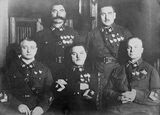
The first five Marshals of the Soviet Union in November, 1935. (l-r): Mikhail Tukhachevsky, Semyon Budyonny, Kliment Voroshilov, Vasily Blyukher, Aleksandr Yegorov. Only Voroshilov and Budyonny survived the Great Purge.
The Great Purge was a series of campaigns of political repression and persecution in the Soviet Union orchestrated by Joseph Stalin in 1936–1938. It involved a large-scale purge of the Communist Party and Government officials, repression of peasants, Red Army leadership, and the persecution of unaffiliated persons, characterized by widespread police surveillance, widespread suspicion of "saboteurs", imprisonment, and executions. In Russian historiography the period of the most intense purge, 1937–1938, is called Yezhovshchina (Russian: Ежовщина; literally, the Yezhov regime), after Nikolai Yezhov, the head of the Soviet secret police, NKVD.
In the Western World, Robert Conquest's 1968 book The Great Terror popularized that phrase. Conquest was in turn inspired by the period of terror (French: la Terreur) during the French Revolution.
Crisis in Newfoundland[]
Newfoundland's economy collapsed in the Great Depression, as prices plunged for fish, its main export. The government had borrowed heavily to construct and maintain a trans island railway and to finance the country's regiment in the first world war. By 1933, the public debt of over $100 million compared to a nominal national income of about $30 million. In 1933, the budget deficit was $3.5 million or over ten percent of the island's GDP. A royal commission under Lord Amulree (Viscount William Worrender McKenzie) reported:
"The twelve years 1920-1932, during none of which was the budget balanced, were characterized by an outflow of public funds on a scale as ruinous as it was unprecedented, fostered by a continuous stream of willing lenders. A new era of industrial expansion, easy money, and profitable contact with the American continent was looked for and was deemed in part to have arrived. In the prevailing optimism, the resources of the Exchequer were believed to be limitless. The public debt of the island, accumulated over a century, was in twelve years more than doubled; its assets dissipated by improvident administration; the people misled into the acceptance of false standards; and the country sunk in waste and extravagance. The onset of the world depression found the island with no reserves, its primary industry neglected and its credit exhausted. At the first wind of adversity, its elaborate pretensions collapsed like a house of cards. The glowing visions of a new Utopia were dispelled with cruel suddenness by the cold realities of national insolvency, and today a disillusioned and bewildered people, deprived in many parts of the country of all hopes of earning a livelihood, are haunted by the grim specters of pauperism and starvation."
In 1934, the Dominion gave up its self-governing status as the Commission of Government took its place. The Commission consisted of six appointed commissioners, who administered the country without elections. Following World War II, the Commission was obliged to revise the constitution and in 1946 held elections for the Newfoundland National Convention which debated the dominion's future in 1946 and 1947. Two referenda resulted in Newfoundlanders deciding to end the commission, and join Canada in 1949, on a 51% vote in the referendum.
Soviet Industrialization[]
The mobilization of resources by state planning augmented the country's industrial base. From 1928 to 1932, peak iron output, necessary for further development of the industrial infrastructure rose from 3.3 million to 6.2 million tons per year. Coal, the integral product fueling modern economies and Stalinist industrialization, successfully rose from 35.4 million to 64 million tons, and output of iron ore rose from 5.7 million to 19 million tons. A number of industrial complexes such as Magnitogorsk and Kuznetsk, the Moscow and Gorky automobile plants, the Urals and Kramatorsk heavy machinery plants, and Kharkov, Stalingrad and Cheliabinsk tractor plants had been built or were under construction.

Early Soviet poster: The Smoke of chimneys is the breath of Soviet Russia
In real terms, the workers' standards of living tended to drop, rather than rise during the industrialisation. Stalin's laws to "tighten work discipline" made the situation worse: e.g. a 1932 change to the RSFSR labor law code enabled firing workers who had been absent without a reason from the work place for just one day. Being fired accordingly meant losing "the right to use ration and commodity cards" as well as the "loss of the right to use an apartment″ and even blacklisted for new employment which altogether meant a threat of starving. Those measures, however, were not fully enforced, as managers often desperately needed to hire new workers. In contrast, the 1938 legislation, which introduced labor books, followed by major revisions of the labor law, were enforced. For example, being absent or even 20 minutes late were grounds for becoming fired; managers who failed to enforce these laws faced criminal prosecution. Later, the Decree of the Presidium of the Supreme Soviet, 26 June 1940 "On the Transfer to the Eight-Hour Working Day, the Seven-day Work Week, and on the Prohibition of Unauthorized Departure by Laborers and Office Workers from Factories and Offices″ replaced the 1938 revisions with obligatory criminal penalties for quitting a job (2–4 months imprisonment), for being late 20 minutes (swix months of probation and pay confiscation of 25 per cent) etc.
Based largely on these figures the Soviet government declared that Five Year Industrial Production Plan had been fulfilled by 93.7 percent in only four years, while parts devoted to heavy−industry part were fulfilled by 108%. Stalin in December 1932 declared the plan a success to the Central Committee, since increases in the output of coal and iron would fuel future development.
During the second five−year plan (1933–37), on the basis of the huge investment during the first plan, industry expanded extremely rapidly, and nearly reached the plan. By 1937 coal output was 127 million tons, pig iron 14.5 million tons, and there had been very rapid developments in the armaments industry.
While undoubtedly marking a tremendous leap in industrial capacity, the first Five Year Plan was extremely harsh on industrial workers; quotas were difficult to fulfill, requiring that miners put in 16 to 18−hour workdays. Failure to fulfill the quotas could result in treason charges. Working conditions were poor, even hazardous. By some estimates, 127,000 workers died during the four years (from 1928 to 1932). Due to the allocation of resources for industry along with decreasing productivity since collectivization, a famine occurred. The use of forced labor must also not be overlooked. In the construction of the industrial complexes, inmates of labor camps were used as expendable resources. But conditions improved rapidly during the second plan. Throughout the 1930s, industrialization was combined with a rapid expansion of education at schools and in higher education.
From 1921 until 1954, during the period of state−guided, forced industrialization, it is claimed 3.7 million people were sentenced for alleged counter−revolutionary crimes, including 0.6 million sentenced to death, 2.4 million sentenced to labor camps, and 0.7 million sentenced to expatriation. Other estimates put these figures much higher. Much like with the famines, the evidence supporting these high numbers is disputed by some historians, although this is a minority view. The peak of the repressions was during the great Purge of 1937–8, and it had the effect of greatly slowing down production in 1937.
Japanese invasion of the USSR and Mongolia[]

Russian troops during the Battle of Khalkin Gol.
On 29 July 1938, the Japanese invaded the USSR and were checked at the Battle of Lake Khasan. Although the battle was a Soviet victory, the Japanese dismissed it as an inconclusive draw, and on 11 May 1939 decided to move the Japanese-Mongolian border up to the Khalkin Gol River by force. After initial successes the Japanese assault on Mongolia was checked by the Red Army that inflicted the first major defeat on the Japanese Kwangtung Army.
These clashes convinced the Japanese government that they should focus on conciliating the Soviet government to avoid interference in the war against China and instead turn their military attention southward, towards the US and European holdings in the Pacific. They also prevented the sacking of experienced Soviet military leaders such as Zhukov, who would later play a vital role in the defence of Moscow.
World War II Broke in Europe[]
It's a Red, Red, Eastern Europe[]

Soviets in occupied Kiev
On 17 September 1939, USSR invaded Finland, Ukraine, Belarus, and Poland and Lithuania. On 19 September 1939 after USSR failed to withdraw in accordance with Austria-Hungary and German demands, Germany and Austria-Hungary, followed by Bulgaria, and the Ottoman Empire, declared war on USSR but provided little military support to their puppets other than a small German attack into Karelia. On 12 October 1939, after signing a non-aggression pact with Japan, the Soviets launched their own invasion of the Cossacks countries. By early October, Poland was divided among German occupied, and the Soviet Union, Finland was in battle and almost annexed, and Ukraine and Belarus were annexed, although Ukraine and Belarus never officially surrendered and continued the fight outside its borders. At the same time as the battle in Eastern Europe, Japan launched its first attack against Changsha, a strategically important Chinese city, but was repulsed by late September.
Finland attacks[]
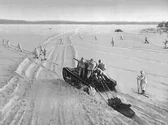
Finnish Soldiers in the War
Following the invasion of Eastern Europe, the Soviet Union forced the Baltic countries to allow it to station Soviet troops in their countries under pacts of "mutual assistance." Finland rejected territorial demands and was invaded again by the Soviet Union in November 1939. The resulting conflict ended in March 1940 with Finnish concessions. France and the United Kingdom, treating the Soviet attack on Finland as tantamount to entering the war on the side of the Germans, responded to the Soviet invasion by supporting the USSR's expulsion from the League of Nations. In June 1940, the Soviet Armed Forces invaded and occupied the neutral Baltic States.
